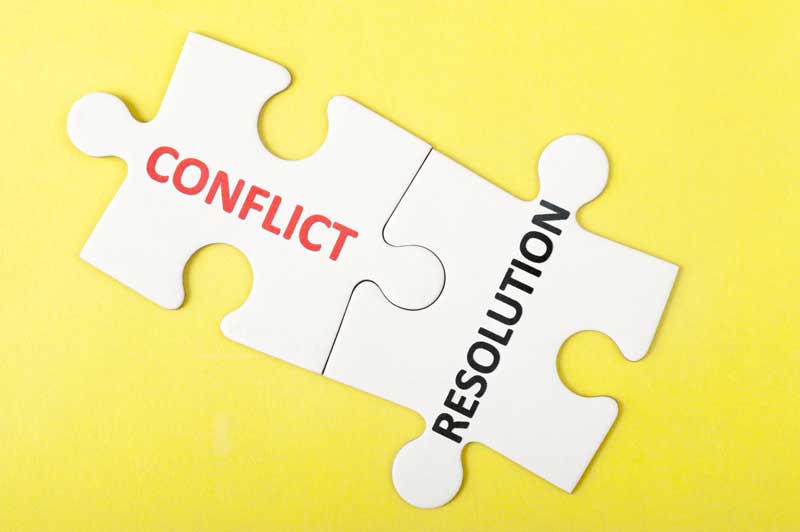How can we bring about change and innovation in the workplace? How can we build stronger, more resilient relationships at home? How can we create open minds in our families and our teams, inviting new questions and new solutions to whatever problems we encounter?
The answer is one you may not want to hear.
The diversity of perspectives, opinions, and personalities that you need to bring forth all of these benefits is uncomfortable. You need conflict.
Conflict is a necessary part of life. Without dissent, there is stagnation and stagnation means death.
You need to reframe conflict to help people be more open about it, including yourself. The last thing you want is problems lingering underneath the surface, never resolved or managed.
A Moving Target
The harmony that you want in your workplace and your house is not a static state that, once reached, remains that way. Instead, harmony is dynamic, a moving target that must be shot at each time a member of your team grows. You need to recalibrate as children and projects change. This takes time and effort but reaps innovation and intimacy.
In a 2013 Stanford study, researchers asked over 200 CEOs where they needed the most help in improving their leadership skills. Over 42% said conflict management. As a CEO, you don’t just deal with “office politics", you need to consider your employees, your customers, and your shareholders.
Being at home isn’t any easier. Balancing the needs and wants of you and your partner with those of your children can be tricky. While your child staying up past 11 pm may not bother you and might be a real desire of theirs, you have to put your foot down because you know what the research says about the health consequences of bad sleep habits.
Not only do you have to weigh what each “interest group” wants at home and in the office, but you also have to figure out what is ultimately good for them in the long term. To accomplish this gracefully, you need to know how to relieve discord.

Conflict Management at Home and Work
Conflict management skills are universal but how you apply them changes depending on who and what you’re dealing with. The emphasis on management instead of resolution comes to us not just through the literature on best practices in business, but also in the home.
Some disagreements are intractable while others are solvable. Whatever the case, you can relieve tension with a few basic conflict management skills:
Define Acceptable Behavior
One of the surest ways to generate conflict is to be unclear about rules and boundaries. If people don’t know who is responsible for what or what behavior is allowed, time will be wasted arguing about standards and energy will be wasted trying to gain favoritism.
At work, don’t allow the lines of responsibility to blur.
Make sure everyone knows their place.
Institute procedures for dealing with conflict and make them known to your team: Are there tools they can use to resolve the conflict themselves? How can team members regard each other amicably in a dispute? Who should they go to in a leadership role if they are unable to manage the disagreement?
At home, the structure you provide your children with is invaluable. Warm parents that encourage independence, set clear limits, and consistently enforce boundaries are known as authoritative parents, and their style produces the best outcomes for children. Tell them where the line is, enforce the line, and empathize with them when that line frustrates their desires.
Practice Perspective Taking
Emotional Intelligence (EQ) is now known as one of the most important skills to have as a leader. The ability to see what other people are feeling and understand their position—called empathy or compassion in the literature—is a key ingredient of EQ.
At work, make it a point to see the issue from all sides.
Steve Jobs famously switched roles and took the position of his opponents when Apple executives were deciding whether to put iTunes on the Windows platform.

Steve Jobs was known for switching roles in order to create better results based on opposing conflict
At home, create a safe space for all family members. Whether it is your partner or child, they need to know that you value their input even in disagreement. Try to take a bird’s eye view of your own positions: Are they reasonable? Is your ego too involved?
Then take the view of the other’s involved in the conflict: What need are they trying to get met?
Lastly, try to take a third-party perspective: What are reasonable concessions to be made on both sides? What advice would you give the people in this conflict?
Encourage Viewing Conflict as Growth
While not all disputes can be resolved, being able to step up to the plate and voice our ideas and concerns is vital to feeling accepted and acceptable. Sometimes conflict will require us to bring forth great creativity. Lacking that, there is room to grow towards each other.
When an ex-employee of the powerful consulting firm McKinsey joined Apple, he brought gavels with him that read “duty to dissent”. He would give them to people who were being too quiet in meetings. Create a culture of innovation by celebrating disagreements and new ideas.
At home, use reason and evidence with your children instead of demanding obedience. While everything absolutely should not be a debate, encourage them to make their argument whenever you aren’t sure what the best course of action is.
Put the Ego Aside
Most importantly, where ever you are, don’t let your ego get in the way of being the best leader you can be.
“I don’t mind being wrong. And I’ll admit that I’m wrong a lot. It doesn’t really matter to me too much. What matters to me is that we do the right thing.”
- Steve Jobs
Developing clear, fair rules, fostering independent thinking, and making sure not to let your ego get in the way will create a thriving, dynamic environment where ever you go. Soon, you will learn to value conflict rather than fear it.












